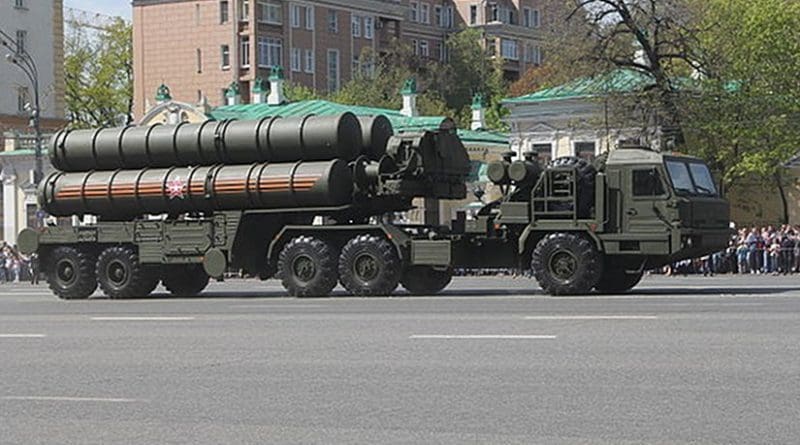America’s Double Standards On S-400 Missile System Sanctions – Analysis
Russia’s ability to sell its S-400 air defense system to several different countries in different theaters illustrates the geopolitics of this particular system. For buyers and policymakers, it is changing the way missile systems are sold by Russia and measures how the US sees these sales from a geopolitical point of view.
Despite US sanctions on the Russian defense company Almaz-Antey, Moscow is offering or has sold the S-400 to a number of countries, including NATO member Turkey. China acquired the first S-400 system, including the command post, radar stations and launching stations, which resulted in the US State Department last month imposing sanctions on China’s Equipment Development Department, the military branch responsible for weapons and equipment, and its director, Li Shangfu, for engaging in “significant transactions” with Rosoboronexport, Russia’s main arms exporter.
The move, made possible by last year’s US congressional passage of the Countering America’s Adversaries Through Sanctions Act (CAATSA), seeks to penalize countries who purchase weapons from Russia, North Korea and Iran. Notably, China is being sanctioned for taking delivery of these systems and not for the conclusion of the sales contracts with Russia. Here, geopolitics by the Donald Trump White House is pushing Russia and China closer together.
The US is also watching closely for other S-400 sales to countries such as Algeria, Belarus, Iran and Vietnam, thus reducing the American sphere of influence and boosting Russia’s ability to arm, equip and train other countries’ air defense capabilities regardless of the theater. The key issue here is what the US will do given the defense requirements of other countries who want to continue to do defense business with Moscow. Both Turkey and, in particular, India now stand out.
Naturally, any sale of the S-400 to Turkey — which is a done deal — has made waves with American officials discussing ways in which to convince Ankara to think otherwise. These measures include pressure tactics such as the threat of sanctions. Questions about the interoperability of the system are obvious and any such sale of the missile system to either one of these countries means it will be standalone in either country’s air defense architecture.
The sale of five S-400 missile systems to India raised eyebrows, however, because the Trump administration and ultimately the US Congress gave New Delhi a pass on penalizing the country for buying the system from Russia. On July 24, the US Senate and House passed a bill that allows India to buy the Russian weapon system without the threat of American sanctions. CAATSA is apparently not set in stone and sales may be judged on a case-by-case basis.
Modifications to CAATSA’s Section 231 enables the US president to waive sales like the S-400 to protect US alliances, like the one it has with India. Importantly, Indian Defense Minister Nirmala Sitharaman made clear that CAATSA was a US law and not a UN law. Negotiations for the S-400 missiles have been ongoing for several years and predates America’s problem with Russian interference in the 2016 presidential election, from New Delhi’s point of view.
Importantly, the US is India’s largest arms supplier after Russia. US firms have sold India more than $10 billion-worth of military hardware, mainly aircraft, over the last decade. The Indian Air Force operates frontline US aircraft such as the C-17 Globemaster, the C-130J Super Hercules and will soon receive Apache helicopter gunships and Chinook transport helicopters. But US policymakers worry that their aircraft’s radar signatures and transmission frequencies being exposed to the S-400 missile system will allow Russia to counter them in other potential conflict zones.
To be sure, India sees the S-400 as part of its strategy to maintain a credible deterrence along two fronts with China and Pakistan, who both have impressive military credentials. This fact means the system can see deep inside Pakistani territory and pick up aircraft as soon as they are airborne. Deployed along the eastern border with China, the missile system can easily monitor fighter jets taking off from airfields along the Tibetan highlands. India’s air defense architecture allows for the S-400 to become integrated into the top layer.
India also sees the S-400 as an answer to its shrinking fighter strength. It is retiring the Russian MiG-21, MiG-27 and MiG-29 aircraft and the last batch of Russian-Indian Su-30 MKI fighters is being produced by Hindustan Aeronautics Limited’s Nashik factory. India is entertaining a number of future fighter procurement packages, especially from France, which are to be delivered in 2021. From an Indian defense doctrine point of view, the S-400 will free up multi-role fighters to do air-to-ground missions instead of an air superiority role, all with America’s permission.
Overall, the US is applying different standards to implementing sanctions when Russian arms sales are involved. Moscow recognizes this fact and Rosoboronexport’s strategy is likely to push more sales of the S-400 and other equipment in order to test American resolve to slap sanctions on as many countries as possible. If the geopolitical game is not appreciated by all parties, this is where the US sanctions policy can backfire.

